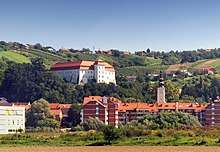Lendava
Lendava is the easternmost town in Slovenia close to triple-border of Croatia, Slovenia and Hungary. Lendava is a center of the Hungarian minority in Slovenia and Hungarian is the second official language in the city.

Understand
The first traces of settlement in Lendava date back to Roman times, when the settlement on the Poetovio–Savaria route (today Ptuj-Szombathely) was named Halicanum. The first mentions of modern Lendava go back to the 9th century, as the church was said to have been consecrated there in 853, and the town of Lindva, named after the local river, was first mentioned in records dating from 1192. Because of its position on the main transit routes, Lendava first grew into a market town in the 14th century, then a parish in 1334. The rulers of Lendava and surroundings in Middle Ages, Hungarian nobles Banffys, started the first developments of the city, and were succeeded by the House of Esterhazy in 1644. The area was under Hungarian and Turkish rule throughout most of the 17th century. In 1867 Lendava became a town and administrative district seat.
Lendava, or in Hungarian Lendva, has a big Hungarian minority, which is normal, considering the long period Lendava was part of Hungary. One third of the population are Hungarians, and every sight in the city is signposted in both Slovenian and Hungarian. Even some statues in the city are of famous Hungarians who lived in Lendava. Despite good relations between countries and harmonious ethnic relations, Lendava is off the beaten path for both countries and many travelers miss this city.
Get in
Get around
See
One of the most interesting sights in the city are its urban vineyards. Lendava wines are among the most famous Slovenian wines.
- 🌍 City Castle (Lendavski grad), Bánffyjev trg 1, ☎ +386 2 578 92 60. 08:00 - 17:00 (weekends until 16:00). Definitely the most interesting sight in the city. The first fortification and castle was built in the 12th century, but it was rebuilt in the 17th century by the Esterhazy family between 1712 and 1717. The castle remained in their possession until the end of World War II. The castle holds a museum with an ordinary collection of Bronze Age artifacts, weaponry from the period of war against the Turks and a small ethnographic collection. 2 euros.
- 🌍 Chapel of St. Trinity (Kapelica sv. Trojstva) (Short walk from main church in Lendava up the hill around wineyards), ☎ +38640 349 613. Chapel St. Trinity was built on the site of the observation post that existed during period of Turkish incursions to alert citizens to the danger from the Turks. Inside the chapel is naturally mummified body which according to legend is considered as a hero fighting against the Turks, Mihael Hadik. It is more likely that it is not the legendary hero of Lendava but about General Mihaly Hadik who died after a heart attack, which occurred due to the shock of head injuries sustained in 1733. Due to the limestone soil body has not disintegrated but remained naturally mummified. Still, it is still not completely scientifically explained why occurred this phenomenon. free.
Do
- Cycling. Cycling is very popular in the Prekmurje region, since it is very flat. There are numerous cycling paths around Lendava and beyond, including some that go to other parts of Slovenia, Croatia and Hungary. Check this list of cycling routes and GPS trails .